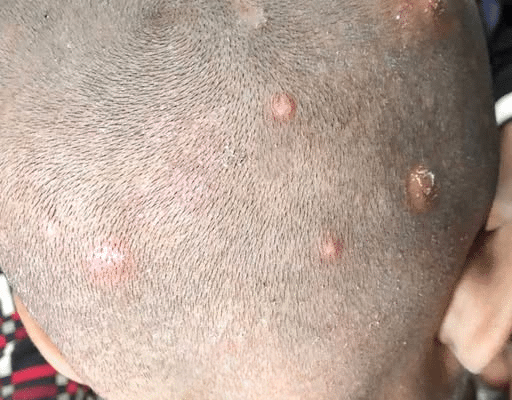Seeing a bump on your child’s scalp may immediately make you worry, mainly if visit to the doctor is not possible for several days or weeks. It makes sense for parents to feel tense and interested in finding explanations.
Knowing that your child’s health and happiness matter a lot, it makes you worry when there are any disturbing skin changes you can’t figure out. Meanwhile, before getting a professional assessment, try to learn what could be troubling your child and steps you can take to help him or her feel better.

A variety of common or more serious conditions may cause scalp bumps in kids. Having information on all the options can reduce your worries and support your choices for treatment and care. Some of the most common types are folliculitis, sebaceous cysts and boils.
The condition folliculitis happens when the hair follicles get inflamed due to infections and this is noticeable by small red bumps that can get filled with pus. Clogged oil glands may cause sebaceous cysts which are normally dome-shaped and cause little or no pain.
Other severe bacterial infections called boils or furuncles, usually turn into painful red lumps that grow larger and fill with pus, needing to be drained.

Finding out what the bumps are is a useful starting point. A red and itchy bump over your hair follicles may be because of scalp folliculitis. It may develop because the skin is irritated by the products used in the hair, tight hairstyles or because of infections.
The region might be sore and sometimes release ooze. When left untreated, folliculitis may grow into hard-to-treat skin infections and result in hair loss.
Checking the clusters for signs like pus, swelling or crusty areas can give you hints. Whenever your child is scratching their scalp, stick to the basic rules of cleaning the scalp and avoid going with harsh products.

Boils must be dealt with extra care. Such lumps are more serious and hurt, as they are usually the result of bacterial infections, most often caused by Staphylococcus aureus. Boils stand out from other lumps because they usually swell larger, feel hot and can be painful.
Fevers and tiredness may be signs that something is happening with the infection. Although pimples can be popped, boils must not be, since it can lead to other problems or spread the infection. Rather, warm compresses applied several times a day can assist in letting the boil come to a head and empty itself.
Call your doctor or go to the hospital right away if a boil does not improve or is paired with a fever.
^BMODEL RELEASED^b. ^BBump^b on a two year old girl’s forehead caused by blow to the head.
” data-medium-file=”https://i0.wp.com/middleagedclub.com/wp-content/uploads/2025/05/54yrtyr564564.jpg?fit=300%2C199&ssl=1″ data-large-file=”https://i0.wp.com/middleagedclub.com/wp-content/uploads/2025/05/54yrtyr564564.jpg?fit=800%2C531&ssl=1″ src=”https://i0.wp.com/middleagedclub.com/wp-content/uploads/2025/05/54yrtyr564564.jpg?resize=800%2C531&ssl=1″ alt=”” srcset=”https://i0.wp.com/middleagedclub.com/wp-content/uploads/2025/05/54yrtyr564564.jpg?w=800&ssl=1 800w, https://i0.wp.com/middleagedclub.com/wp-content/uploads/2025/05/54yrtyr564564.jpg?resize=300%2C199&ssl=1 300w, https://i0.wp.com/middleagedclub.com/wp-content/uploads/2025/05/54yrtyr564564.jpg?resize=768%2C510&ssl=1 768w” sizes=”(max-width: 800px) 100vw, 800px” />
Some indications require emergency medical assistance even if your next appointment is still days ahead. Ask for medical attention if your child has fever, seems tired, the bumps keep expanding quickly or are causing more pain. Swelling in or around the eyes or face,
difficulty swallowing or acting strangely may be signs of a significant underlying health concern that must be looked at right away. If your child has an immunity issue due to a long-term illness or treatment, be very careful about any skin changes.
You can apply some low-key treatments at home to make your child more comfortable as you watch and treat their symptoms. A warm compress is often very soothing and effective when dealing with a painful bump like a boil. They assist in the natural flow of body fluids and aid draining of the lymphatic system.
Using aloe vera gel on the rash may soothe itching and mild redness. Properly diluted tea tree oil may help with folliculitis because it is known to have antibacterial and antifungal effects. Never forget to do a patch test to make sure you aren’t allergic and do not use essential oils on broken or sore skin unless told to by a professional.

Taking over-the-counter medications can also give relief. When the irritation is just mild and not getting worse, medicated shampoos with ketoconazole, selenium sulfide or zinc pyrithione may ease your scalp and address fungal problems.
Creams that contain hydrocortisone may help with inflammation and itching when used instructed by a doctor. If you follow the instructions on the pack, medicines for pain such as acetaminophen or ibuprofen, can make your child more comfortable until you get more advice from a doctor.
Looking after your scalp hygienically is very important for handling and avoiding problems. Remind your child to wash their hair fairly often, when they sweat or play sports and to select shampoos that do not have strong chemicals or fragrances.
Guide them to keep their personal hats, combs and towels for themselves to stop the spread of germs. Make sure to rinse properly after shampooing, because residue can irritate the scalp or stop hair from growing.

Today, you can find lots of viral social media hacks for treating scalp problems. Even though they sound like they may help, a lot of these treatments have no scientific foundation and may hurt more than they help.
Applying straight baking soda or apple cider vinegar may further irritate or dry out the child’s scalp. Take time to learn about the solution before trying it and if you are unsure, get advice from a medical expert, even using virtual services when needed.
Taking care of your child’s comfort is equally important as finding out what the problem is. Avoid the temptation to scratch, pick or squeeze the bumps since this can make your skin break and bring in more bacteria.
Cut their nails so they are not too long and put soft cotton hats on if their bumps feel sensitive. Cooling the affected area can ease itchiness and things like listening to stories, music or playing quietly can draw their mind off the discomfort.

If it’s not easy to see a doctor face-to-face, especially for less serious problems, telehealth can be very helpful. Remotely consulting your pediatrician online is now a possibility, helping you explain the symptoms, send pictures and get directions for treatment.
Print the path and changes the bumps have taken—start date, how they appear, any symptoms that go along with them and the reactions to home remedies. When the healthcare provider has this information, they can give better advice.
Being prepared ahead of your doctor visit can help you make best use of the meeting. Shoot some clear photos from different sides of the scalp to document the changes. Log any bumps that appear along with any tenderness, itching, fevers and treatments in your diary.
Using this detailed method, the doctor can make the right diagnosis and you can feel at ease knowing you’ve done everything necessary to keep your child healthy before seeing a doctor.
More:-
Say Goodbye to Dry Skin: 9 Proven Remedies for Flaky Skin
Nine ways to improve dry and flaky skin
Most people suffer from dry skin, particularly during the winter months. The air starts to lose moisture when the temperature drops, which has an impact on our bodies and causes dry skin.
You may, however, take a number of clever precautions to make sure that this doesn’t happen to you. By following these guidelines, you may maintain your soft skin throughout the year.

To learn more about how to keep your skin appearing hydrated and supple, continue reading!
In addition to the time of year, several behaviors can exacerbate conditions like dry skin. Another factor that can cause your skin to get dry is taking long, hot showers. The good news is that there are numerous methods to keep your skin hydrated and prevent dry skin.
Our skin starts to dry out as soon as we shower or wash our faces since the water dries quickly. It is preferable to use a moisturizer shortly after to seal in the moisture. Avoid taking a shower in too hot water, and use a towel to dry yourself without rubbing too hard. Always use a sharp razor and shaving gel when shaving.
Additionally, as hands are the most vulnerable to dryness during the winter, it is important to always moisturize them after washing. Experts advise you to think about purchasing a humidifier for your house.
In addition, we’ve included some advice to help you always stay well moisturized.
Olive Oil
Dry skin can be greatly alleviated by using extra-virgin olive oil. However, it might not be a good idea to utilize it excessively. According to certified aesthetician Jennifer Adell, “olive oil contains vitamin E, antioxidants, squalene, and other properties that repair damaged skin.” In Westport, Connecticut, she works as the senior aesthetician at New Beauty and Wellness.

Olive oil can help soften your skin and reduce inflammation, according to research. On the other hand, using it alone could damage your skin barrier. Therefore, adding a few drops to your face masks or applying it to dry parts of your body that are not your face—like your elbows—might be a better choice.
Cereal
It’s possible that you’ve heard about oatmeal baths for itchy skin. To aid in hydration, it’s also a good idea to add a cup of oats to your warm bath. It relieves dry and irritated skin.
Oil from coconuts
Dry skin is one of the many home cures that employ coconut oil. Tsippora Shainhouse, MD, advises using coconut oil as a moisturizing lotion before bed or at any time because it solidifies at room temperature. According to Shainhouse, it is particularly advantageous. “Apply the oil to chapped hands and heels, then cover with non-latex gloves or thick socks.”

The Compress for Milk
According to Shainhouse, “milk has natural anti-inflammatory properties.” According to her, “it also contains lactic acid, a mild, natural exfoliant.” This removes dead cells from your skin while also hydrating it. However, you should not use this procedure if you have cracked skin.
A clean washcloth can be soaked in a bowl of cold milk to create your own milk compress.
aloe Vera
In addition to being used as an aftershave balm, aloe vera can also relieve dryness. Aloe vera aids in retaining moisture in the skin because it also includes mucopolysaccharides like hyaluronic acid. Before using it all over your body, we advise you to try a small area of your skin.

Honey Another excellent topical remedy for dryness is honey. It offers anti-inflammatory and healing benefits, according to research. It can be applied as a spot therapy to specific body parts that are very dry or harsh. Once more, we advise testing a patch before applying it to larger regions.
Petroleum Jelly
Petroleum jelly, commonly marketed as Vaseline or Aquaphor, is a popular choice. Particularly during the colder months, the majority of individuals always keep a bottle of it at home.
Petroleum jelly is the primary ingredient used in these two brands. It greatly aids in reducing dryness and provide chaffing prevention. Additionally, applying it to your body is really safe. Naturally, though, if you have skin that is prone to acne, you must exercise caution while putting it to your face, chest, or back.
Products for Dry Skin
These days, there are several products on the market designed especially to address dry skin. Lotions are not advised by the American Academy of Dermatology Association; instead,
ointments or creams are. Dimethicone, shea butter, glycerin, hyaluronic acid, lactic acid, lanolin, mineral oil, petrolatum, and jojoba oil are among the chemicals they advise people to watch out for.
Free of Fragrances
Choosing skincare products that don’t have any scent is another excellent suggestion. This is not equivalent to “unscented,” as these still contain ingredients that assist mask the product’s aroma.

It is essential to speak with a professional specialist, such as a dermatologist, if you follow these suggestions and nothing seems to change.
Give them these pointers so they can maintain healthy skin throughout the chilly winter months!
Related content_width: default_width imagefilter_options: initial imagefilter_options_hover: initial imagefilter_applyto: initial
Related




Please tell me more about your excellent articles http://www.kayswell.com